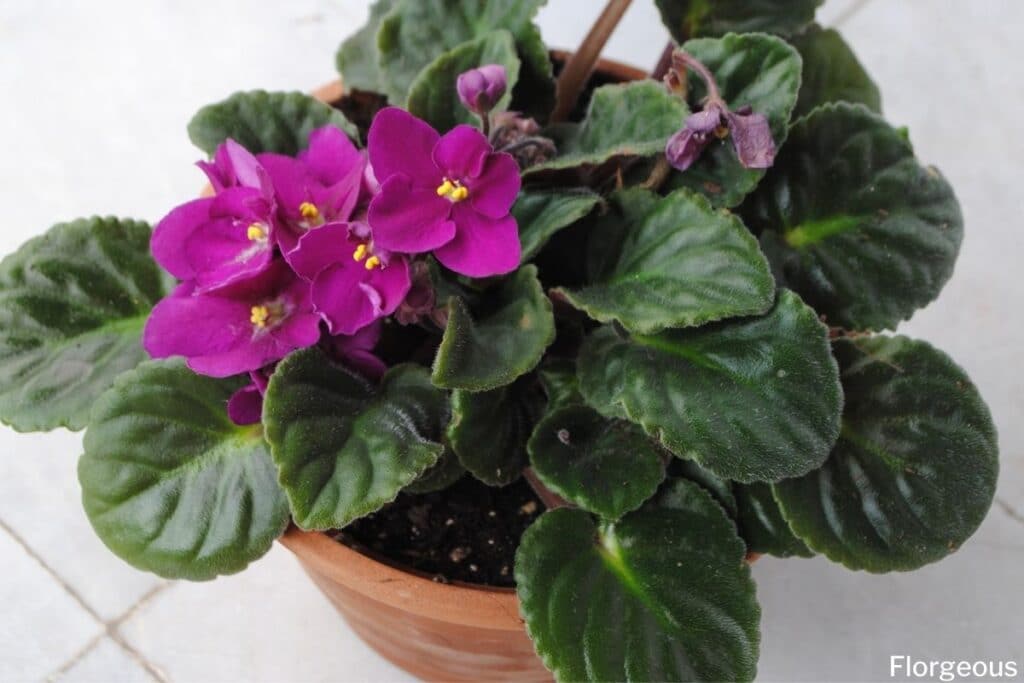Do you know that the health of your African violets reflects their soil condition? It is time to listen to what your plant is telling you. In most cases, yellowing and other plant problems are not caused by a disease or an insect.
Understanding soil is one of the most important things to learn when it comes to African violet care. Most signs and symptoms show because of the growing medium the plant is grown.
Read on to know the right potting mix for African violets.
What is the Best potting mix for African Violet
Since the African violet (Saintpaulia) originated in Africa, it is often seen growing on porous rocks and mossy areas. Given this information, the growing medium should mimic the same characteristics given by the African violet’s natural environment.
To understand what type of mixture would be most suitable, you must know the four key characteristics: aeration, water retention, anchorage, and availability of nutrients. These four are highly affected by the texture of the mix.
Saintpaulia prefers a growing mix with high porosity and good drainage. This preference is because the plant has a sensitive root that may be damaged by waterlogging. Some growing mixes are already pre-made by different companies to cater to the African violets. But before buying, you must also take into consideration the environment at home.
Unknown to many, the material you use for your pots affects the growth of your plant. It goes hand in hand with the soil in moisture control. If you are using a clay pot, it is porous, and water can seep through it. This characteristic leads to loss of moisture through evaporation. On the other hand, plastic pots keep it sealed, and there are no pores to fill, but it causes more chances of waterlogging. Each has its pros and cons.
Proper watering is essential regardless of the type of pot you choose. Whether it’s clay or plastic, ensuring that your plants receive the right amount of room temperature water is crucial for their health and growth.
Remember to choose the perfect potting mix that will suit your plant’s needs. Also, check it with other growing requirements. For example, if you often forget to water your plants, you should opt for a plastic pot to retain moisture longer.
For example, if your indoor plant corner is humid, pick a mixture rich in organic matter as it will help retain moisture in the soil. If you have an automated irrigation system, more loose and porous soil should be used, an example of which are mixtures with bigger soil particles and rougher textures. Using this type of African violet potting mix will avoid waterlogging and give room for gas exchange so the delicate roots can breathe.
Best Soil Mixture Recipe for African Violets
There are various types of commercial growing mediums designed specifically for African violets. However, you could also opt to create your mixture. The recommended African violet potting soil recipe is as follows: 1 peat moss or leaf mold:1 garden soil:1 sand, perlite, or vermiculite. This mixture will provide the best texture for African violets. If these materials are available, remember to pasteurize the growing mix to be sure that it is disease-free.
What is Soil Pasteurization
There are 3 ways to pasteurize your mixture. The first is by exposing it to the sun for days and mixing it every day. This is advisable if you have an open area with direct sunlight. Also, this is recommended during very hot days.
The next method is for small amounts of growing media. The moist mixture is put in an oven-safe pan covered in tin foil. Then, put the pan in an oven set in 180 deg Fahrenheit and let it stay there for an hour.
The last method is called the barbeque method. It is basically like barbecuing your mixture. At 160 degrees Fahrenheit let the mixture cook for 30 minutes. Let the mixture rest for at least 4 days and remember to mix it every day to provide aeration. Also, remember to not let the temperature reach more than 180 degrees Fahrenheit. With that heat, the beneficial soil bacteria would be killed and that is not what we are going for.
Best Soilless Growing Mixture for African Violets
Moreover, some people do not prefer using a growing mixture with soil. This reason is why they go for a soilless mix. The Cornell modified peat lite soilless mixture recommends the use of the following: ½ quarts of peat moss: ¼ quarts of vermiculite: ¼ quarts of perlite: 1 tablespoon of limestone: ¼ teaspoon of superphosphate.
FAQs
What soil for common violet?
Common violets (Viola sororia) prefer well-draining, slightly acidic soil with a pH between 6.0 and 7.0. A mixture of equal parts peat moss, perlite, and potting soil or a commercial potting mix designed for African violets can provide the ideal growing medium.
Do African violets like coffee grounds?
While African violets can tolerate a variety of soil amendments, including coffee grounds, it’s best to use them sparingly. Excessive use of coffee grounds can increase soil acidity, which may not be suitable for African violets.
Do African violets like dry soil?
African violets prefer consistently moist soil but not overly wet or waterlogged conditions. Allowing the soil to dry out completely between waterings can stress the plants and lead to issues like leaf wilting and root rot.
Are eggshells good for African violets?
Crushed eggshells can be beneficial for African violets as they provide a slow-release source of calcium, which can help prevent blossom end rot and strengthen cell walls in the plant.
What is the best soil recipe for African Violets?
A popular soil recipe for African violets includes a blend of peat moss, perlite, and vermiculite or a commercial potting mix specifically formulated for African violets. This diy african violet soil provides good drainage, aeration, and moisture retention, creating an ideal growing environment for these plants.
See more: African violet fertilizer







